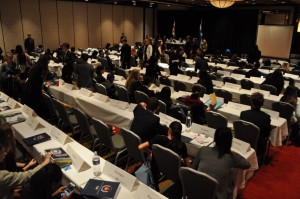SSUNS 2015: From ”Bow-Tie” Plans to the ”Trident” Group: High-School Students Tackle Natural Disaster Risk Reduction


The Montreal edition of the United Nations-sponsored World Conference of Disaster Risk Reduction saw constructive debates and innovative resolutions aiming at the prevention and mitigation of the effects of natural disasters. The second day of the conference saw the first tangible proposals to tackle this issue in the shape of four draft resolutions. The debate surrounding these resolutions further proved plenty of the political creativity that anyone would wish to see emerging from such concerted efforts of the international community.
From the onset, the delegates were reminded of the importance of providing multi-facetted approaches to the issue at hand. Disaster Risk Reduction (DRR) is a highly complex field, touching upon issues of climate change, world poverty, agriculture and gender. The latter may seem like a curious variable in a discussion on earthquakes and tsunamis, but research has shown that women are substantially more at risk from natural disasters,[1] but also that they have a colossal potential in accelerating the recovery process, [2] making “gender mainstreaming” essential to risk reduction. That world poverty is a key factor in assessing vulnerability seems much more obvious, yet the conference went further, stressing the need to reduce poverty as a long-term risk reduction measure. The spreading of modern technology like surveillance centers and satellite monitoring was also discussed as a major element to improve worldwide reaction to natural disasters.
The conference also included the intervention of a qualified outside speaker in Dr. Heather McKeen-Edwards of Bishop’s University. Praising the efforts of the conference and the focus on gender, the global governance expert brought home the importance of funding schemes in debating resolutions. Dr. Edwards highlighted that while a lot of money is currently dedicated to humanitarian aid, only 13.5 billion (less than 2%) have gone to actual DRR in the past two decades. “Not a great percentage”, she commented, even though she admitted that her numbers mainly contained government funding and did not cover not NGO activity. She further noted that the distribution of the present funds is highly uneven, with lower-middle-income countries like Bangladesh or Ethiopia getting most of it and low-income countries like Haiti being left out. Her intervention informed the debate of the delegates on various possible types of funding schemes, such as “shared” investments with high involvement of the recipient country or funding as humanitarian aid. Choosing wisely amongst these schemes would ultimately determine “who you are encouraging to run the show” in DRR, she told the delegates.
In light of the complexity of the issue, the delegates must be praised for not losing sight of the larger picture. The resolutions submitted showed great care to cover the entire spectrum of DRR-related issues. The need to educate local populations to risks and prevention methods was stressed by all, be it through “vocational centers” or even the creation of an “educational pairing” alliance between individual developed and developing nations proposed by the “Triple Focus Collaborative Bloc”. All resolutions further agreed on the paramount importance of NGOs in mitigating natural disaster risks. Great attention was further given to the economic development of all areas at risk, with the “Coalition of Developing Nations” suggesting systems of regional agricultural subsidies and the micro-financing of local business initiatives. Further commendable qualities of the proposals was the transparency of their financing, with several draft resolutions mapping out the origin and distribution of funds in detail; and the care devoted to include concrete measures, such as the “Foundations for the Future” group’s endorsement of Hydrogel as an eco-friendly fertilizer in disaster risk areas.

None of this is to say that the conference went by seamlessly. Long rounds of formal debates and informal negotiations were needed to make any progress. Within the coalitions that eventually formed, the delegates had to face the difficulty of crafting resolutions through consensus, a daunting task for some groups numbering up to 24 sponsors. Yet progress was continuous throughout the day, with debates showing widespread agreement on the core objectives and issues of the conference, leaving WCDRR chair Marta Canneri greatly impressed. “It’s always hard to manage such a big event and to keep everyone engaged, but I could not have asked for a better group”, she told MIR as talks were adjourned, remaining confident that a resolution would be passed before the end of the conference on Sunday.
Sources
1. Briceño, Sálvano. Gender Perspectives: Integrating Disaster Risk Reduction into Climate Change Adaptation. Rep. N.p.: United Nations International Strategy for Disaster Reduction, 2008. United Nations. Web. 10 Apr. 2015.
2. Aguilar, L., et al. (2008). Training Manual on Gender and Climate Change. San José, Costa Rica: IUCN, UNDP, GGCA.
Photo credit to Matthew Meyer
